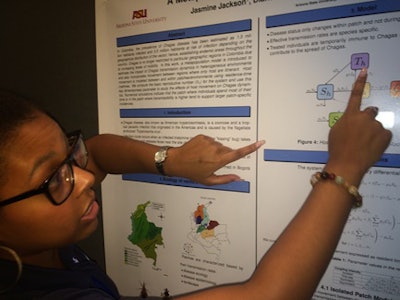 Jasmine Jackson, a second-year Ph.D. student of applied mathematics at Arizona State University, shows her poster that details the threat of the deadly “kissing bugs,” which have been spotted in certain parts of the United States.
Jasmine Jackson, a second-year Ph.D. student of applied mathematics at Arizona State University, shows her poster that details the threat of the deadly “kissing bugs,” which have been spotted in certain parts of the United States.NATIONAL HARBOR, MD — Bugs with a deadly bite. Waterborne pathogens that threaten our health. Bad breath and gum disease.
These are some of the practical problems being tackled by students involved in the Louis Stokes Alliance for Minority Participation, a federally funded program meant to broaden participation among underrepresented minorities in the STEM fields.
The students’ hard work manifested itself in the form of research posters on display this week at the LSAMP Research Symposium 2016.
Poster No. 85—titled Porphyromonas Gingivalis Vima-Vime is Collectively Involved in Virulence Modulation—belonged to Samuel Bagley, 19, a sophomore biomedical science major at Oakwood University.
He said the statistics on the porphyromonas gingivalis show that one out of two adults over the age of 30 suffer from the disease but that what often gets overlooked is that the rates for the gum disease are significantly higher among minorities. He and his team of researchers were searching for a way to deliver a cure for the disease—associated with a host of problems that range from bad breath to diabetes—via toothpaste.
“If you don’t have African-Americans studying the disease, we may not get the cures we need, the treatments we need as a population because the people studying it aren’t necessarily looking out for our best interests,” said Bagley, an aspiring MD Ph.D.
Poster No. 94 belonged to Zaira Grijalva, who surveyed her campus at Maricopa County Community College for Legionella pneumophila—a bacterium that causes Legionnaires’ disease. She found that it was present at normal levels but still required treatment and monitoring.
Grijalva said it’s important for minorities to get involved in studying problems such as waterborne diseases to make sure that society’s institutions protect the population—a need illustrated by the Flint water crisis in Michigan.
She also said that, as a young mother of two, she dropped out of college in Mexico and thought school was out of reach when she came to the United States.
“I wouldn’t even think about going back to school,” she said. But by having the mentoring and financial support of the LSAMP program, which in her case includes a $1,000-a-semester stipend, she felt encouraged enough to return to school.
Poster No. 43—titled A Metapopulation Model of Chagas Disease in Colombia with Human Mobility—belonged to Jasmine Jackson, a second-year Ph.D. student of applied mathematics at Arizona State University.
Jackson admitted she was “a little scared” of being bitten by a “kissing bug” when she went to Bogota, Colombia, last year with a team of mathematicians to study the effect that human mobility patterns had on the spread of the deadly Chagas disease. People can contract the disease from the parasitic bugs when they bite people on their mouths while they sleep.
But she was assured that the deadly kissing bugs—insect vectors formally known as triatomine bugs—were not in Bogota because it is so high in the mountains.
Jackson said the best thing people can do to ward off the kissing bugs, which have been spotted in certain parts of the United States, is to get their houses sprayed with a certain insecticide and keep the palm trees outside their homes cut low.
She believes LSAMP is important not just because it diversifies the population of students who study STEM fields but it helps bring about a diversity of ideas.
“You have to have a diverse pool of scientists because my ideas can be different from a Latina’s ideas or a White American’s ideas because our cultures are different,” Jackson said. “So it’s very important to have a diverse group of people work together.”



















